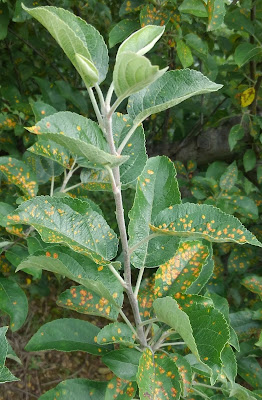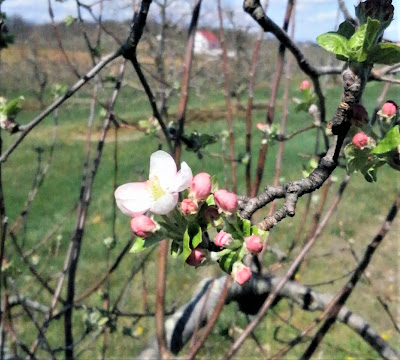Six extended wetting events since Jul 22 have dramatically increased summer disease pressures in the Winchester area: Jul 22: 6 hr wetting at 73° with 0.9 in. rain, Jul 23-24: 13 hr wetting at 73° with 0.51 in. rain, Jul 30-31: 21 hr wetting at 70° with 1.01 in. rain; Aug 1-2: 15 hr wetting at 72° with 0.45 in. rain, Aug 3-4: 19 hr wetting at 68° with 0.92 in. rain; and Aug 6: 6 hr wetting at 68° with 0.2 in. rain. Suffice it to say that Winchester's extended dry conditions of July have passed! Wetting events at these temperatures have favored development of sooty blotch and flyspeck and the rot fungi. Evidence of early season (scab), mid-season (Brooks spot), and late season diseases (sooty blotch and developing rots) is shown below:
Scab, sooty blotch and rot spots on unprotected Granny Smith fruit at Virginia Tech AREC, Winchester, VA, Aug 10, 2020.Infection by Brooks spot (8 o'clock and 1 o'clock positions from the calyx), as well as sooty blotch and rot spots on unprotected Idared fruit, Aug 10, 2020. Infection by Brooks spot, one of the earliest "summer diseases", typically occurs about a month after petal fall.
Accumulated wetting hours through the summer can be an indicator of summer disease pressure, particularly to predict the development of the sooty blotch and flyspeck (SBFS) fungal complex, but also can be a general indicator of rot pressure. To predict SBFS, we record accumulated wetting hours (ACW) from rainfall, fog, or dew, starting 10 days after petal fall. The action threshold of 250 ACW predicts that the SBFS fungi are present on unprotected fruit when the threshold is reached, and symptoms will soon appear with further incubation. Winchester passed the 250-hr threshold on July 21, and symptoms are now present on unprotected fruit, as shown above, with symptoms heavier at lower elevations, which have more wetting hours. Here is a listing of selected petal fall dates and current total wetting hour accumulation (ACW) for selected locations as of Aug 10: Winchester, May 5, 393 ACW; Staunton, May 5, 823 ACW; Roanoke, Apr 18, 447 ACW; Floyd, Apr 28, 470 ACW; Manassas, Apr 28, 694 ACW; Sperryville, Apr 28, 387 ACW; Crozet, Apr 18, 423 ACW; Carter Mountain, Apr 18, 558 ACW; Red Hill, Apr 18, 483 ACW; Lynchburg, Apr 13, 647 ACW; Rustburg, Apr 13, 573 ACW; Danville, Apr 13, 832 ACW.
Unless unusual fruit disease-related events occur, this will be the final post for this year. With approaching harvest, carefully observe pre-harvest intervals and per acre per year restrictions for all fungicides and all crop protection products.













